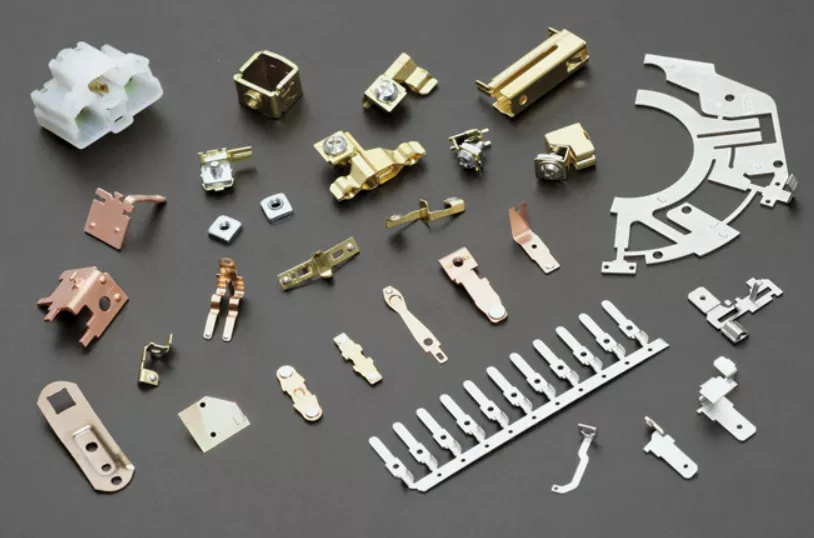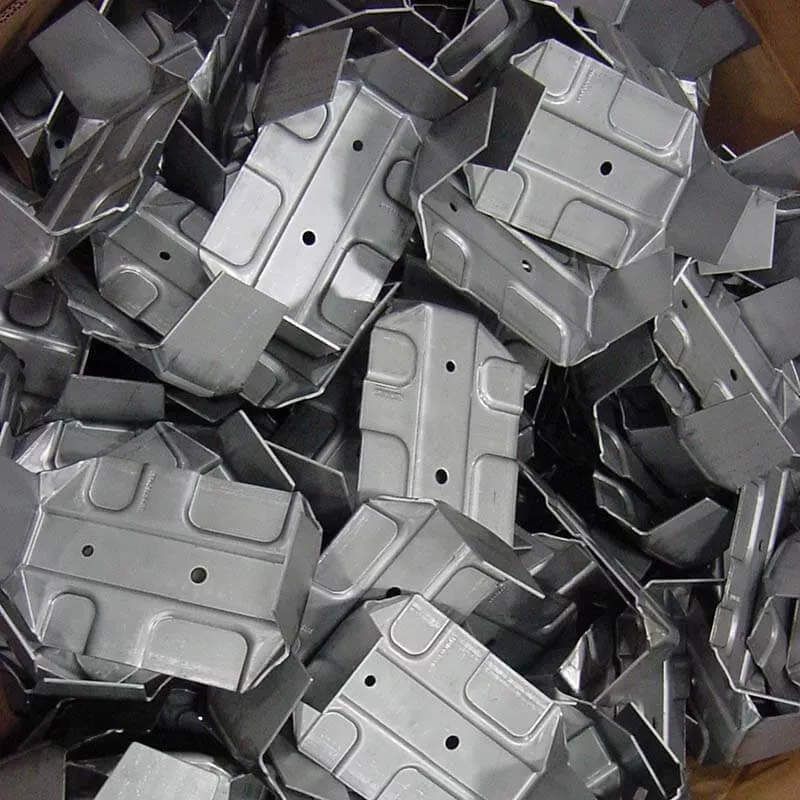Our Stamping Services
Rjcmold is a metal stamping manufacturer with high-volume progressive die metal stamping production service meeting ISO 9001:2015 quality standards.
Our custom metal stamping service uses a combination of high-speed presses and progressive dies to provide the most cost-effective solution for high volume manufacturing. When appropriate we design & build specialized manufacturing cells utilizing automation for high-volume, low-cost production.
All stamping tools and dies are engineered and produced in-house, including high speed progressive stamping dies, lamination stamping dies, compound dies, notching dies, forming dies, shallow draw dies, and fineblanking dies among others. We are experts at working with a variety of die materials including A2, D2, carbide, and high speed steel.
Our combined 20 years of tool and die design and build experience enables us to provide complete metal stamping services that include comprehensive engineering services, including part application consulting, material selection, production consulting, and reverse design production.

The Stamping Process
Metal stamping is a manufacturing process in which coils or flat sheets of material are formed into specific shapes. Stamping encompasses multiple forming techniques such as blanking, punching, embossing, and progressive die stamping, to mention just a few. Parts use either a combination of these techniques or independently, depending on the piece’s complexity. In the process, blank coils or sheets get fed into a stamping press which uses tools and dies to form features and surfaces in the metal. Metal stamping is an excellent way to mass-produce various complex parts, from car door panels and gears to small electrical components used in phones and computers. Stamping processes are highly-adopted in automotive, industrial, lighting, medical, and other industries.
Custom Metal Stamping Capabilities
Rjcmold manufactures custom metal stampings in various materials, including copper, brass, stainless steel, and steel alloys. We offer production volumes up to over one million stamping parts and maintain tight tolerances, all with competitive lead times. Please take advantage of our precision metal stamping service by starting an online quote at the top of this page.
Our standard sheet metal stampings can make small, medium, and large parts. Rjcmold’s has a maximum press bed length of 10 feet and a maximum press bed width of 20 feet. We can readily stamp metal thicknesses from .025 – .188 inches but can go up to .25 inches thick and beyond, depending on the forming technique and material used.
Our project managers and experts personally review and manually quote each metal stamping project to ensure we meet your unique needs while providing a fast and easy manufacturing experience.
Types of Stamping We Offer
Depending on the specific needs of your project, we have a wide variety of different types of metal stamping, including:
- Progressive Die Stamping uses multiple dies and steps to create deeper parts than would typically be achievable through single dies. It also enables multiple geometries per part as they go through various dies. This technique is best suited to high volume and large parts such as those in the automotive industry. Transfer die stamping is a similar process, except progressive die stamping involves a workpiece attached to a metal strip pulled through the entire process. Transfer die stamping removes the workpiece and moves it along a conveyor.
- Deep Draw Stamping creates stampings with deep cavities, like enclosed rectangles. This process creates rigid pieces since the extreme deformation of the metal compresses its structure into a more crystalline form. Standard draw stamping, which involves shallower dies used to shape the metal, is also commonly utilized.
- Fourslide Stamping shapes parts from four axes instead of from one direction. This method is used to manufacture small intricate parts including electronics components such as phone battery connectors. Offering more design flexibility, lower production costs, and faster manufacturing times, fourslide stamping is popular in aerospace, medical, automotive, and electronics industries.
- Hydroforming is an evolution of stamping. Sheets are placed on a die with a bottom shape, while the upper shape is a bladder of oil that fills to high pressure, pressing the metal into the shape of the lower die. Multiple parts can be hydroformed simultaneously. Hydroforming is a quick and accurate technique, though it requires a trim die to cut the parts out of the sheet afterward.
- Blanking cuts pieces out from the sheet as an initial step before forming. Fineblanking, a variation of blanking, makes precise cuts with smooth edges and a flat surface.
- Coining is another type of blanking that creates small round workpieces. Since it involves significant force to form a small piece, it hardens the metal and removes burrs and rough edges.
- Punching is the opposite of blanking; it involves removing material from the workpiece instead of removing material to create a workpiece.
- Embossing creates a three-dimensional design in the metal, either raised above the surface or through a series of depressions.
- Bending happens on a single axis and is often used to create profiles in U, V, or L shapes. This technique is accomplished by clamping one side and bending the other over a die or pressing the metal into or against a die. Flanging is bending for tabs or parts of a workpiece instead of the whole part.
Materials We Use
At Rjcmold. Incorporated, we believe in using the highest quality materials for your punch press stamping project. Poor quality materials create parts that don’t last long or hold up to the wear and tear that our customers (and their customers) routinely put on the parts. It’s important that your punch pressed parts are able to withstand the demands that will be put on them every day.
We use:
- Steel
- Cold and hot rolled carbon steel
- Galvanized steel
- Aluminum
- Aluminized sheet metal
- Galvannealed coated carbon steel
- Stainless steel
- Brass
- Copper
- Bronze
Which material you choose depends largely on your project specifications, what the part will be used for, and the budget you have available.

Tight Tolerances
Our precision metal stamping services can deliver your part’s desired shape, whether you’re in the aerospace, automotive, telecommunications, or electronics industry. Our strive to meet your tolerance requirements by iterating on the tool and die design to fine-tune the output to meet your needs. However, the tighter the tolerances, the more challenging and costly this becomes. Precision metal stampings with tight tolerances can be brackets, clips, inserts, connectors, fittings, and other parts in consumer appliances, electrical grids, planes, and automobiles. They’re also used to create implants, surgical instruments, temperature probes, and other medical device parts like housings and pump components.
Regular checks to ensure the output still measures up to specifications are typical for all stamping after each successive run. Quality and consistency are part of a Total Productive Maintenance (TPM) program to detect wear in stamping tools (commonly made of D2 steel). Measurements with a check-fixture (or check-gauge) are standard for long-run stamping lines.
Metal Stamping by Industry
Top-quality punch pressed parts are needed for numerous applications. From furniture brackets and circuit board parts to lifesaving medical devices, Rjcmold Incorporated has the ability to create durable, long-lasting parts for nearly limitless needs. We serve many industries, including:
- Aerospace
- Electronics
- Medical devices
- Industrial
- Pet supply
- Health and cosmetics
- Electric motors
- Plumbing
- Security devices
- Transportation
- Public safety
- Foodservice
- HVAC
- Audio/video
- Furniture
Why Choose Rjcmold for Your Punch Press Stamping Needs?
Serving the World
Shipping custom quality metal stampings around the globe, Rjcmold provides you world-class quality assurance and precision stamping technology. Stamping your parts from stainless steel, aluminum, HSLA, Steel, copper, and other metals demands precision. Our ISO 9001 registered quality system assures you defect-free stamped metal parts with the tolerances you need and at high volume production rates. Conforming component parts, shipped on time, and using the most economical processes is what makes Rjcmold your best value manufacturing partner.
Whether you’re an engineer starting a project and seeking high volume-high value metal stamping capabilities, or a purchasing professional looking for a quality-driven metal stamping manufacturer, let us quote your metal stamping requirements today.


